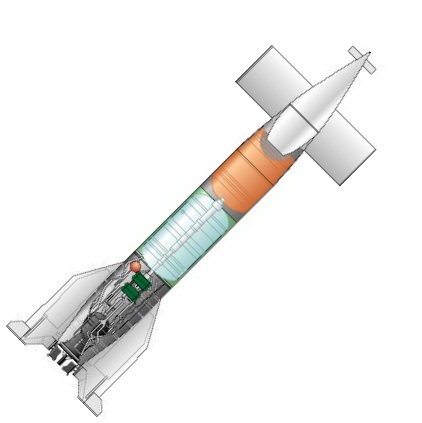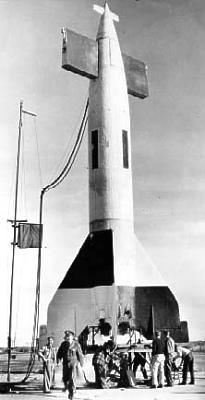
Home - Search - Browse - Alphabetic Index: 0- 1- 2- 3- 4- 5- 6- 7- 8- 9
A- B- C- D- E- F- G- H- I- J- K- L- M- N- O- P- Q- R- S- T- U- V- W- X- Y- Z
Hermes B-1

Hermes B-1
Credit: © Mark Wade
AKA: Hermes II;RTV-G-3;RTV-G-6;SSM-A-9;SSM-G-9. Status: Retired 1950. First Launch: 1947-05-30. Last Launch: 1950-11-09. Number: 4 . Payload: 230 kg (500 lb). Thrust: 267.00 kN (60,023 lbf). Gross mass: 14,400 kg (31,700 lb). Height: 15.70 m (51.50 ft). Diameter: 1.65 m (5.41 ft). Span: 5.41 m (17.74 ft). Apogee: 200 km (120 mi).
The ramjet portion of the Army's Hermes program, like all post-war ramjet efforts, remains shrouded in secrecy. A confusing maze of designations was applied at various points in the project. It was deeply classified at the time -- test launches do not appear in official V-2 launch lists -- and it seems to remain unknowable to what extent flight experiments progressed.
The concept of a ramjet-augmented A9 had already been sketched out at Peenemuende. German research into ramjet propulsion remains largely undocumented, but after the war German teams in Russia, Britain, France, and America all were put to work developing missiles using the new form of propulsion. In America and Russia the boost-glide concept of the A9 and Saenger Silverbird were both quickly dropped in favor of ramjet-powered Mach 3 cruise vehicles, indicating that this conclusion had already been reached in Germany before the end of the war.
Von Braun's team at White Sands made testing of a ramjet-powered missile one of their earliest priorities. The Hermes B, already proposed by Hermes contractor in 1946, was a conventional 12 m long cruise missile with a conventional cylinder + conical shock body inlet ramjet. The Germans wished to pursue the Hermes II, a more radical linear ramjet concept. In tests a V-2 would be used to get the second stage 'Ram' missile up to ramjet ignition speed.
The Ram second stage had a 4.65 m wingspan. The stub wings incorporated the 'Organ' linear ramjets. The missile's base nestled into a recess built into the top of the V-2's fuel tank. In a test flight, the V-2 would take the second stage to supersonic speed at 15,000 m altitude, then separate. The Ram would coast to 20,000 m, then the ramjet would be ignited and the stage would cruise at over 3500 kph. It was expected the ramjet would generate a thrust of 13.1 kN, and the stage carried 634 kg of 'zip fuel' (jet fuel with boron hydride additive), enough for 400 seconds of powered flight. It was expected an operational missile version would have a range of 800 km with a 230 kg payload. The Ram stage had a diameter of 1.29 m, a length of 5.44 m, a total mass of 2563 kg. Nearly as important as the radical propulsion was the inertial guidance system, which controlled operation of both the first and second stages.
On its very first test, which was with an instrumented but inactive ramjet, the V-2 veered off-course. Telemetry indicated expected air flow in the ramjet ducts, but the second stage provided aerodynamic lift and glided at Mach 3 out of the White Sands test range. It blew a 10 m diameter crater in a cemetery south of Juarez, Mexico. The Peenemuende Germans joked 'We were the first German unit to not only infiltrate the United States, but to attack Mexico from US soil'. The Army was however not amused and two further tests planned for later that year were cancelled. Component tests of the conventional ramjet planned for the Hermes B were carried out on three V-2 flights in 1947-1949. However the next tests of the Ram stage did not come until 1949-1950. There is no record of the results or whether they carried live ramjets.
Work on Hermes ramjet vehicles continued after the German team was moved to Huntsville Alabama. It was by 1952 envisioned the Hermes II would travel at Mach 4.5 at 24 km altitude over a 2400 km range. But the decision was taken that the US Air Force would be solely responsible for long-range cruise missiles, and the Hermes II was cancelled in September 1953. The equivalent Air Force Navaho would reach flight test in 1957, only to be cancelled in turn in favor of simpler ballistic missiles.
Maximum range: 500 km (310 mi). Boost Propulsion: Lox/alcohol. Cruise engine: GE Ramjet. Maximum speed: 3,500 kph (2,100 mph).
Designations Discussion (© Andreas Parsch)
The Hermes B program was begun in 1946 with the ambitious goal to develop a ramjet-powered surface-to-surface cruise missile to carry a 450 kg (1000 lb) warhead over a range of 1600 km (1000 miles) at a speed of Mach 4. The payload and range requirements were subsequently increased to 2260 kg (5000 lb) and 2400 km (1500 miles). Because Mach 4 ramjets were way beyond the state-of-the-art in 1946, the Hermes B would require a long-term research effort. Therefore the project was split into the Hermes B-1 ramjet test vehicle and the Hermes B-2 operational missile. In 1946, the U.S. Army also established the Hermes II project, which was a broadly-defined general missile research effort to be conducted by a group of German scientists at the U.S. Army's Ordnance Research and Development Division at Ft. Bliss, TX. The first task of the Hermes II group was to design and fly a ramjet test vehicle in support of the Hermes B program. Later, in early 1948, the U.S. Army assigned the formal designations RTV-G-3, RTV-G-6 and SSM-G-9 to the Hermes II, Hermes B-1 and Hermes B-2 missiles, respectively.
The Hermes II test vehicle was actually the first flight-test article of the whole Hermes program. The missile consisted of a V-2, which had a ramjet-powered second stage (called "Ram") mounted semi-recessed on top. The "Ram" was a small vehicle with large wedge-shaped wings, which actually housed small rectangular-section ramjet units. This peculiar device was also called the "Organ". The V-2 first stage had enlarged fins to improve stability of the whole Hermes II missile. The Hermes II was launched into an arched trajectory, and after burnout of the V-2 engine, the "Ram" was to be separated from the V-2 by diffential aerodynamic drag. As soon as the "Ram" was no longer climbing, the ramjet units were to ignite and propel the vehicle to a speed of about 1000 m-s (3200 ft-s). The "Ram" was to carry a newly developed advanced gyro-inertial stabilization and guidance system. The first flight of a Hermes II occurred in May 1947, and used only a mockup "Ram" with dummy (non-burning) ramjets to measure dynamic pressures in the ramjet ducts. Although the flight was unsuccessful (the missile veered off course, crashing in Mexico(!)), some preliminary data was obtained.
*Note: Drawing shows original V-2 fins (RTV-G-3 as flown had larger ones)
Although further Hermes II flights were originally planned for 1947, these were postponed. The three remaining RTV-G-3 flights eventually occurred in January 1949, October 1949 and November 1950, but it is unclear whether the three latter flights carried a "Ram" with live ramjets and-or released the "Ram" into free flight. However, this seems relatively unlikely given the apparently reduced priority of Hermes II and the fact that the original schedule had planned free-flying inertially-guided live "Rams" only for flight #6 and later. The RTV-G-3 Hermes II was redesignated RV-A-3 in mid-1951.
Whether there were any RTV-G-6 Hermes B-1 vehicles (redesignated RV-A-6 in mid-1951) is a matter of debate. There are many sources which refer to the Hermes II missile described and illustrated in the preceding paragraphs as "RTV-G-6", "RTV-A-6" (which is incorrect in any case; see note (4) on designation table below) and-or "Hermes B-1". This is actually not surprising, because the RTV-G-6-RV-A-6 was planned to be the ramjet test vehicle of the Hermes B program, and the RTV-G-3-RV-A-3 Hermes II effectively was exactly that! Furthermore, by 1951 the U.S. Army apparently used the same project number for the RV-A-3 and RV-A-6, and there is also a common project summary report for RV-A-3-RV-A-6. There are several possibilities (the first one is in my opinion by far the most likely, and the last two are almost certainly incorrect):
- The RV-A-6 was to be a completely new ramjet-powered missile, possibly closer to the projected Hermes B-2 tactical missile. If so, no RV-A-6 was ever built.
- The RV-A-6 designation was transferred to the Hermes II, when it became clear that the latter would remain the only ramjet test vehicle for the Hermes B program. If so, the RV-A-3 and RV-A-6 are actually identical.
- The RV-A-6 designation was applied to the "Ram" upper stage of the RV-A-3.
- There were three launches of V-2s with (non-burning) cylindrical ramjet ducts on top to test Hermes B propulsion technology. The RV-A-6 designator might have been applied to these tests.
The history of the projected tactical SSM-G-9 Hermes B-2, redesignated SSM-A-9 in mid-1951, is a bit unclear. Source [1] says it was cancelled in June 1950, and this is confirmed by a U.S. Army document from 1951, which lists the SSM-A-9 program as "completed". On the other hand, source [3] (an official U.S. Army history document) quotes a termination date of 1954 for the Hermes B program. However, all relevant sources agree that work on an operational ramjet-powered missile was continued after the completion of the RTV-G-3 flight tests until September 1953 under the Hermes II-RV-A-3 program. The final specifications called for a rather impressive cruise missile, flying over a range of 2400 km (1500 miles) with a speed of Mach 4.5 at 24000 m (80000 ft). These studies apparently included static firings of ramjets (quite possibly related to a projected RV-A-6 vehicle), but no all-up missile flight tests. Whatever the details are, no actual XSSM-G-9 (XSSM-A-9) Hermes B-2 missiles were ever built.
Family: tactical ballistic. Country: USA. Engines: Model 39. Launch Sites: White Sands LC33, White Sands. Stages: A-4 stage. Agency: GE.
 | Hermes B-1 |
Back to top of page
Home - Search - Browse - Alphabetic Index: 0- 1- 2- 3- 4- 5- 6- 7- 8- 9
A- B- C- D- E- F- G- H- I- J- K- L- M- N- O- P- Q- R- S- T- U- V- W- X- Y- Z
© 1997-2019 Mark Wade - Contact
© / Conditions for Use